Eric The Viking
Established Member
- Joined
- 19 Jan 2010
- Messages
- 6,599
- Reaction score
- 76
Inexpert review: the Stanley 'Sweetheart' #92 shoulder plane
(or 'wishing my first impressions were deceptive, but fearing they're not')
Bigger pictures are at: http://www.flickr.com/photos/8602695@N05/sets/72157623833611252/, with apologies for the poor quality of some of them.
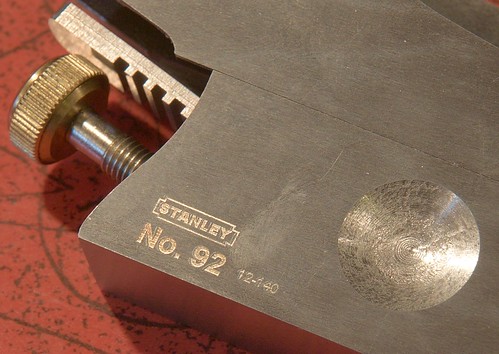
This is a first-impressions review of the new Stanley 'Sweetheart' #92 shoulder plane.
The fulfilment of a long-held ambition
I've wanted one of the original #92s for many years, ever since I got my #90 in fact, but funds have never permitted. Children and DIY necessities do that to you, and it's always been too far down the list to make the cut. But in December last year, I noticed the new 'premium' design was out, much cheaper than the originals, and pretty stylish too. Well, I had some Christmas money, and was putting an order into D&M Tools anyway... I thought I'd treat myself.
So it finally arrived on Thursday, after a three-month wait, and I've been itching since then to unpack it and try it out. I made a bit of space on the bench upstairs for the pictures, and was intending to get on with a job it would have been useful for on the adjacent bathroom project. This bench, incidentally, is usually used for electronics and general repairs, hence the old lurex Formica. There is some wood in there, somewhere...
... anyway, my plan was to take a few snaps, quickly strop the blade and have a proper play. But frustratingly, I didn't get quite that far ](*,)
So what arrived in the post?
Here are the the obligatory box shots:
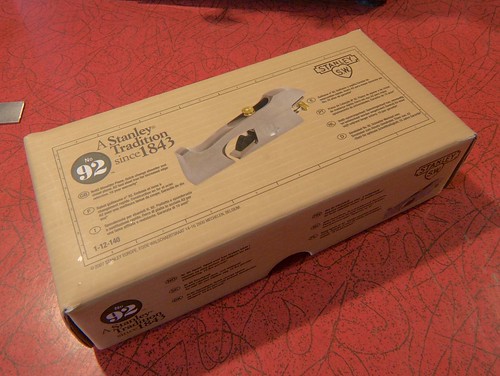

The box is big, thick cardboard, and will probably last longer than the old one for my #90 (which I still have after about 30 years, but which now mainly resembles a well-used beermat). There was also a fairly thick outer protective box too, which I've discarded (and it was all packed carefully in bubble-wrap by D&M), but I was surprised there was no real packaging inside the box. There was only the thick blue plastic bag, with, oddly, the rust-preventing paper folded up outside it. The plane, however, was well greased, and in good condition. I've cleaned most of it off for the pictures.
Also included are a multi-lingual book of instructions (roughly 450,000 languages, two pages for each). It's got horrid tiny printing (about 5-point!), and it doesn't say too much. Crucial instructions, notably about how Stanley think you should set the mouth (see below) are not included. There is a reply paid envelope for the ten year guarantee, which I will be using shortly (you can read that in an ominous tone!).
What's in a lifetime?
The guarantee is worth a mention: Stanley describe it as 'limited lifetime'. If you read the small print, you'll find this means it only applies to the first owner, and ceases if the plane is ever re-sold.
This is annoying: guarantees/warranties are given by manufacturers as a marketing activity, to enhance the impression of a quality product, and as a way of 'proving' their goods are well made. This simply shouldn't depend on who owns the item. The implication is that Stanley are trying to reap the perceived benefits of a long warranty, without being actually prepared to stand behind their product - sneaky in my opinion. Still, the warranty is there, and if it hasn't failed after ten years it probably isn't going to either.
The plane itself
So this is what's inside the wrapping:
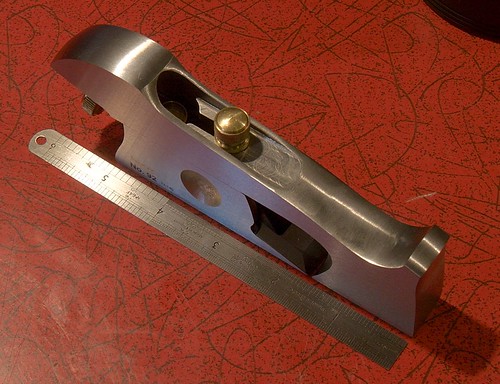
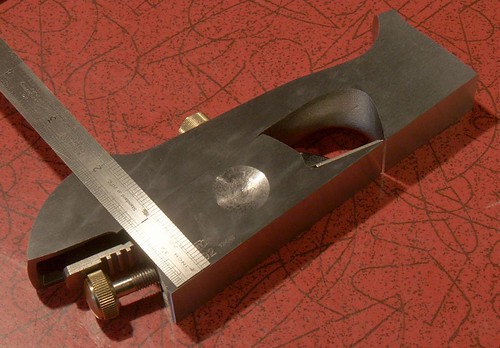
It does indeed look rather pretty. It's a comfortable fit in the hand too, and the exterior finish is generally fairly good. It's not up to Veritas' or LN's standards, but then it costs a fraction of their prices.
I'm not sure if it's a grade of stainless, or just polished, but it's not plated like the earlier versions. There are some signs of blunt tooling (or incorrect milling practice) having been used in manufacture though. Scuff-marks are visible in the second picture above, in the thumb indent: you can see tearing of the metal quite clearly, and it feels rough to the touch. This is a subject I'll return to later.
Like the #90, #92 and #93 planes that preceded it, this #92 converts to a thumb plane simply by removing the nose. This isn't radically different from my old #90:
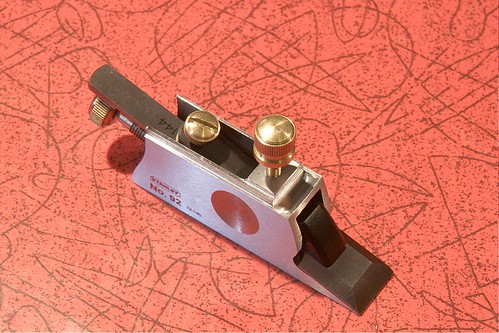
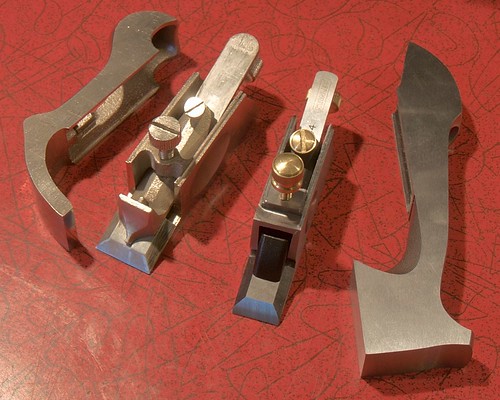
There are a couple of interesting things to note though: Firstly, the cap iron is slightly different. The older design is pointed and curved on the bottom, presumably intended to steer the shavings clear. This never worked! I quickly got used to shoving a wad of shavings out with the thumb sideways, and it could be a right pain with softwood, as things could jam-up pretty fast. Given that the #92 is 3/4" rather than 1" width, I expect this to be less of a problem, and Stanley seem to have gone for solidity in the new design.
It also has a bar in the plane body (which you can't see in the pictures), across the top of the cap iron and on which it can exert downward leverage. This is a distinct improvement, as the old design uses the stirrup into which the nose screw threads, and the cap iron adjustment can be a bit hit and miss as a consequence.
The business end
Stanley make much of the blade being A2 steel, and the instruction book says it's sharpened 'ready for use'. I beg to differ on this slightly: it's not bad, and it would definitely cut, but it could be sharper. The picture below shows that the back, although fairly smooth, isn't quite the mirror finish achievable, and I found that a quick strop on the leather wheel of my sharpener improved things quite a bit.
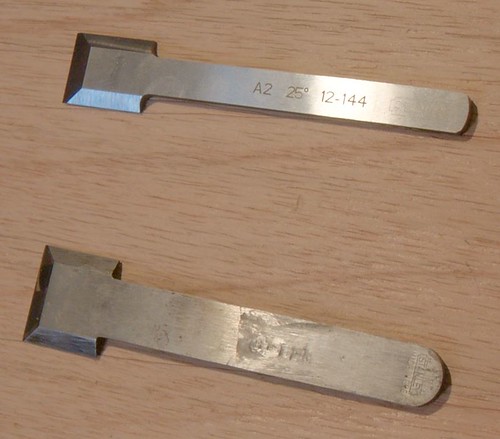
The #92 blade is the upper one! It's looks good, being laser or water-jet cut, but on mine there is one large imperfection on one side, close to the edge, a hole in fact. It's about 1/32" across, and will eventually leave that edge of the blade ragged when sharpened down that far. I'm hoping that, it being A2 steel'n'all, that won't be in my lifetime. For now it's square and sharp.
There is one other significant difference too, compared to the old design: as supplied, my old #90 blade was deliberately bent, as you can see below (right). It's convex, with a bend in the bottom end of the narrow part, so that the cap iron pushes against it to flatten it. The bend makes it a pig to hone, as it doesn't fit into honing guides at all easily, but it can be done. The advantage is surprising: in use, the cap iron puts the blade under compression against the back lip of the plane's mouth, making it chatter-free and easy to adjust.
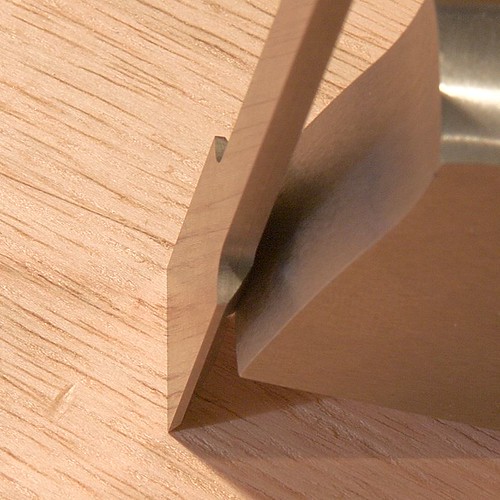
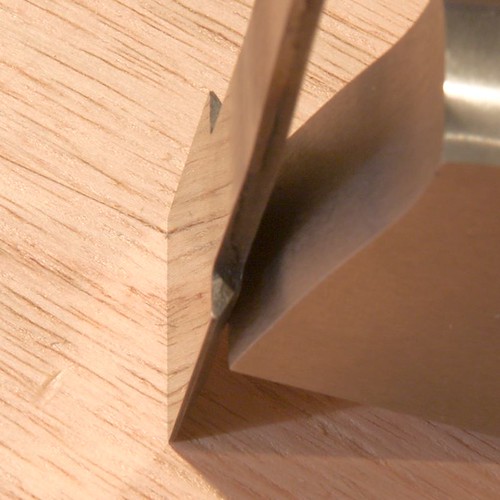
The new iron is flat, and its cap iron clamps it against the whole length of the fixed 'frog.' This may work out OK in practice, but initially, I've had difficulty in getting a good adjustment on the cap screw - too tight and it jams solid, too loose and the blade just slides about. It also puts on the pressure too far to the back. The blade actually lifts away at the mouth -- the exact opposite effect to what's needed! It might be fixable with fettling, but then why should you need to do this?
Spoiling the ship?
Now I must come to more awkward issues. One is design and the other apparently execution. Taken together, they do, in my opinion, spoil an otherwise tight little ship.
There is one crucial difference in the old and new plane designs, that I instantly found infuriating, and which leaves me slapping my forehead, Homer Simpson-like, and shouting 'Doh!' to the plane gods. It's the mouth adjustment, or, in the case of the new plane, the lack of it.
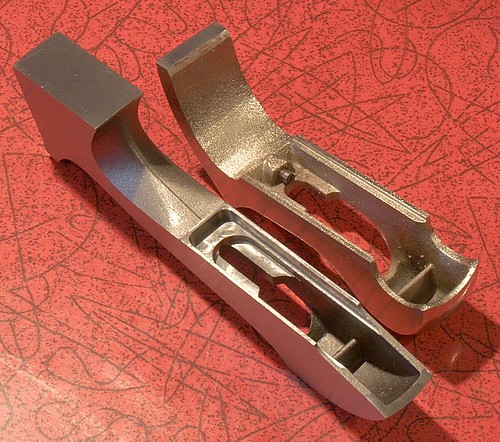
If you look at the picture above, you can see the grub screw/stop that Stanley originally used on all the planes in the old series. It's simple and effective: you unwind the screw to open up the mouth, and wind it in to tighten it up. The only nuisance is that you need another (third!) screwdriver size for just that screw alone, but it does allow you to set the mouth, quickly and exactly. You can whip the top off for thumb-planing operations, and go back to normal in a second or two. Simples!
In the new one, however, the adjustment screw is ENTIRELY MISSING.
I cannot overstate how stupid and annoying this is. When setting the thing up, the slightest slip of the fingers (or insufficient tightening of the nose clamp screw) will result in the nose crashing backwards into the sharp edge of the blade. If the blade happens to be retracted at that point, above the plane of the sole, it will be sharp no longer!
What would it have cost Stanley to drill and tap one small hole, and include a matching grub screw? This one omission seriously limits the usefulness of the plane as a whole. You daren't take the top off, for fear of losing the crucial mouth setting, and adjusting it at the start of a planing operation will be hit and miss - hopefully mainly miss, as 'hit' will surely blunt the iron!
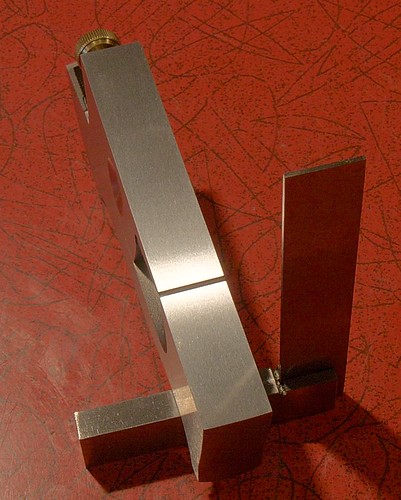
The mouth, without the iron in place, closes up far too much. If the iron didn't project enough, and the nose slipped, it would be instantly blunted!
Whilst getting ready to write this, I came across the esteemed Mr Cohen's comparative review of three shoulder planes, including the old #92 design. Derek is critical of the inability to quickly remove the blade, hone it and return to the original settings. I guess I'm used to it, and can fairly quickly set the plane to work again afterwards, but this new Stanley design will be a total showstopper, magnifying his reasonable criticisms several times over.
I've had a careful measure-up, incidentally. There is just enough room to get a long-series drill in from the back end of the plane, so in theory I might drill and tap it for a screw (although fitting a tap wrench in there will be interesting, in the Chinese curse sense, I fear). But again, why should I have to do this?
The old design wasn't perfect, but at least it worked. On two counts - the cap iron/frog arrangement and the mouth adjustment - this design simply doesn't. You can't fix the problems with time, patience and wet'n'dry paper, either. You'd need a machine shop!
It looks to me like Stanley have gone for aesthetics and cost over function. It's got 'marketing exercise' written all over it. What a shame!
The second shame, incidentally, is the finish, which affects usage as well. I mentioned earlier the poor milling in places. You can see this particularly in the supposedly flat surface of the nose's keyway:
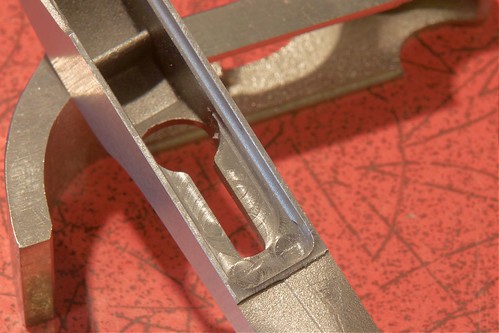
In order to get the two halves of the plane to slide together at all easily, I found it necessary to put honing paste on the slides, and work one against the other to free up the mechanism. They now do slide, and grip when the screw is tightened. In a few months of use, however, because the keyway isn't truly smooth, the plane will inevitably tend to skip and jam up, and I'm expecting fine adjustment to become impossible. I can't then repeat the Autosol trick, as doing it several times will cause the back of the plane to move out of alignment with the nose. There isn't much metal there (the bearing surface is only the outer edges of the plane!), so any grinding action will quickly have an effect.
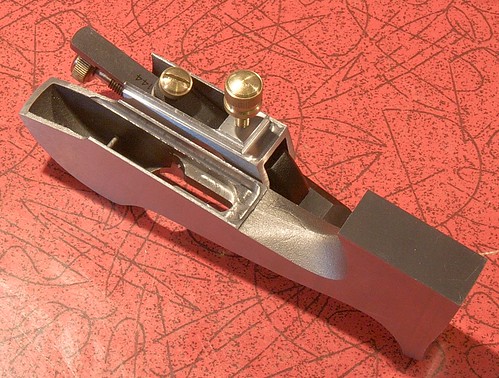
In conclusion...
It looks cute. It ought to be cute. It's very nearly cute.
It's spoiled by detail though, and fatally so, IMHO. It looks to me as though Stanley rushed this into production without field testing. Their earlier published drawings show different designs for the heel of the plane (wood) and for the nose (a lever, rather than a clamping screw). They've obviously been kicking ideas around for ages, but what they've settled on simply isn't practical.
I know I'll find it frustrating if I accept it as-is, and that's a great shame. I've wanted one of these for nigh-on thirty years, and now I'm disappointed.
Oh, and I expect you'll be wondering if I managed to make shavings. The answer is, not really. I found if you close up the mouth to a sensible amount, the nose and the back move out of alignment with each other and you can't then plane with it, certainly not cross-grain in any meaningful way. It's late, and I'll try again in the morning after re-sharpening it, but I'm not optimistic.
Yes, you probably guessed: my last pass through this afternoon resulted in a nicked blade, when the nose collided with the iron, just as predicted.
So right now, Stanley get a C for design, an E-minus for effort, and their marketing department get a loud raspberry. What a shame.
(or 'wishing my first impressions were deceptive, but fearing they're not')
Bigger pictures are at: http://www.flickr.com/photos/8602695@N05/sets/72157623833611252/, with apologies for the poor quality of some of them.

This is a first-impressions review of the new Stanley 'Sweetheart' #92 shoulder plane.
The fulfilment of a long-held ambition
I've wanted one of the original #92s for many years, ever since I got my #90 in fact, but funds have never permitted. Children and DIY necessities do that to you, and it's always been too far down the list to make the cut. But in December last year, I noticed the new 'premium' design was out, much cheaper than the originals, and pretty stylish too. Well, I had some Christmas money, and was putting an order into D&M Tools anyway... I thought I'd treat myself.
So it finally arrived on Thursday, after a three-month wait, and I've been itching since then to unpack it and try it out. I made a bit of space on the bench upstairs for the pictures, and was intending to get on with a job it would have been useful for on the adjacent bathroom project. This bench, incidentally, is usually used for electronics and general repairs, hence the old lurex Formica. There is some wood in there, somewhere...
... anyway, my plan was to take a few snaps, quickly strop the blade and have a proper play. But frustratingly, I didn't get quite that far ](*,)
So what arrived in the post?
Here are the the obligatory box shots:


The box is big, thick cardboard, and will probably last longer than the old one for my #90 (which I still have after about 30 years, but which now mainly resembles a well-used beermat). There was also a fairly thick outer protective box too, which I've discarded (and it was all packed carefully in bubble-wrap by D&M), but I was surprised there was no real packaging inside the box. There was only the thick blue plastic bag, with, oddly, the rust-preventing paper folded up outside it. The plane, however, was well greased, and in good condition. I've cleaned most of it off for the pictures.
Also included are a multi-lingual book of instructions (roughly 450,000 languages, two pages for each). It's got horrid tiny printing (about 5-point!), and it doesn't say too much. Crucial instructions, notably about how Stanley think you should set the mouth (see below) are not included. There is a reply paid envelope for the ten year guarantee, which I will be using shortly (you can read that in an ominous tone!).
What's in a lifetime?
The guarantee is worth a mention: Stanley describe it as 'limited lifetime'. If you read the small print, you'll find this means it only applies to the first owner, and ceases if the plane is ever re-sold.
This is annoying: guarantees/warranties are given by manufacturers as a marketing activity, to enhance the impression of a quality product, and as a way of 'proving' their goods are well made. This simply shouldn't depend on who owns the item. The implication is that Stanley are trying to reap the perceived benefits of a long warranty, without being actually prepared to stand behind their product - sneaky in my opinion. Still, the warranty is there, and if it hasn't failed after ten years it probably isn't going to either.
The plane itself
So this is what's inside the wrapping:


It does indeed look rather pretty. It's a comfortable fit in the hand too, and the exterior finish is generally fairly good. It's not up to Veritas' or LN's standards, but then it costs a fraction of their prices.
I'm not sure if it's a grade of stainless, or just polished, but it's not plated like the earlier versions. There are some signs of blunt tooling (or incorrect milling practice) having been used in manufacture though. Scuff-marks are visible in the second picture above, in the thumb indent: you can see tearing of the metal quite clearly, and it feels rough to the touch. This is a subject I'll return to later.
Like the #90, #92 and #93 planes that preceded it, this #92 converts to a thumb plane simply by removing the nose. This isn't radically different from my old #90:


There are a couple of interesting things to note though: Firstly, the cap iron is slightly different. The older design is pointed and curved on the bottom, presumably intended to steer the shavings clear. This never worked! I quickly got used to shoving a wad of shavings out with the thumb sideways, and it could be a right pain with softwood, as things could jam-up pretty fast. Given that the #92 is 3/4" rather than 1" width, I expect this to be less of a problem, and Stanley seem to have gone for solidity in the new design.
It also has a bar in the plane body (which you can't see in the pictures), across the top of the cap iron and on which it can exert downward leverage. This is a distinct improvement, as the old design uses the stirrup into which the nose screw threads, and the cap iron adjustment can be a bit hit and miss as a consequence.
The business end
Stanley make much of the blade being A2 steel, and the instruction book says it's sharpened 'ready for use'. I beg to differ on this slightly: it's not bad, and it would definitely cut, but it could be sharper. The picture below shows that the back, although fairly smooth, isn't quite the mirror finish achievable, and I found that a quick strop on the leather wheel of my sharpener improved things quite a bit.

The #92 blade is the upper one! It's looks good, being laser or water-jet cut, but on mine there is one large imperfection on one side, close to the edge, a hole in fact. It's about 1/32" across, and will eventually leave that edge of the blade ragged when sharpened down that far. I'm hoping that, it being A2 steel'n'all, that won't be in my lifetime. For now it's square and sharp.
There is one other significant difference too, compared to the old design: as supplied, my old #90 blade was deliberately bent, as you can see below (right). It's convex, with a bend in the bottom end of the narrow part, so that the cap iron pushes against it to flatten it. The bend makes it a pig to hone, as it doesn't fit into honing guides at all easily, but it can be done. The advantage is surprising: in use, the cap iron puts the blade under compression against the back lip of the plane's mouth, making it chatter-free and easy to adjust.


The new iron is flat, and its cap iron clamps it against the whole length of the fixed 'frog.' This may work out OK in practice, but initially, I've had difficulty in getting a good adjustment on the cap screw - too tight and it jams solid, too loose and the blade just slides about. It also puts on the pressure too far to the back. The blade actually lifts away at the mouth -- the exact opposite effect to what's needed! It might be fixable with fettling, but then why should you need to do this?
Spoiling the ship?
Now I must come to more awkward issues. One is design and the other apparently execution. Taken together, they do, in my opinion, spoil an otherwise tight little ship.
There is one crucial difference in the old and new plane designs, that I instantly found infuriating, and which leaves me slapping my forehead, Homer Simpson-like, and shouting 'Doh!' to the plane gods. It's the mouth adjustment, or, in the case of the new plane, the lack of it.

If you look at the picture above, you can see the grub screw/stop that Stanley originally used on all the planes in the old series. It's simple and effective: you unwind the screw to open up the mouth, and wind it in to tighten it up. The only nuisance is that you need another (third!) screwdriver size for just that screw alone, but it does allow you to set the mouth, quickly and exactly. You can whip the top off for thumb-planing operations, and go back to normal in a second or two. Simples!
In the new one, however, the adjustment screw is ENTIRELY MISSING.
I cannot overstate how stupid and annoying this is. When setting the thing up, the slightest slip of the fingers (or insufficient tightening of the nose clamp screw) will result in the nose crashing backwards into the sharp edge of the blade. If the blade happens to be retracted at that point, above the plane of the sole, it will be sharp no longer!
What would it have cost Stanley to drill and tap one small hole, and include a matching grub screw? This one omission seriously limits the usefulness of the plane as a whole. You daren't take the top off, for fear of losing the crucial mouth setting, and adjusting it at the start of a planing operation will be hit and miss - hopefully mainly miss, as 'hit' will surely blunt the iron!

The mouth, without the iron in place, closes up far too much. If the iron didn't project enough, and the nose slipped, it would be instantly blunted!
Whilst getting ready to write this, I came across the esteemed Mr Cohen's comparative review of three shoulder planes, including the old #92 design. Derek is critical of the inability to quickly remove the blade, hone it and return to the original settings. I guess I'm used to it, and can fairly quickly set the plane to work again afterwards, but this new Stanley design will be a total showstopper, magnifying his reasonable criticisms several times over.
I've had a careful measure-up, incidentally. There is just enough room to get a long-series drill in from the back end of the plane, so in theory I might drill and tap it for a screw (although fitting a tap wrench in there will be interesting, in the Chinese curse sense, I fear). But again, why should I have to do this?
The old design wasn't perfect, but at least it worked. On two counts - the cap iron/frog arrangement and the mouth adjustment - this design simply doesn't. You can't fix the problems with time, patience and wet'n'dry paper, either. You'd need a machine shop!
It looks to me like Stanley have gone for aesthetics and cost over function. It's got 'marketing exercise' written all over it. What a shame!
The second shame, incidentally, is the finish, which affects usage as well. I mentioned earlier the poor milling in places. You can see this particularly in the supposedly flat surface of the nose's keyway:

In order to get the two halves of the plane to slide together at all easily, I found it necessary to put honing paste on the slides, and work one against the other to free up the mechanism. They now do slide, and grip when the screw is tightened. In a few months of use, however, because the keyway isn't truly smooth, the plane will inevitably tend to skip and jam up, and I'm expecting fine adjustment to become impossible. I can't then repeat the Autosol trick, as doing it several times will cause the back of the plane to move out of alignment with the nose. There isn't much metal there (the bearing surface is only the outer edges of the plane!), so any grinding action will quickly have an effect.

In conclusion...
It looks cute. It ought to be cute. It's very nearly cute.
It's spoiled by detail though, and fatally so, IMHO. It looks to me as though Stanley rushed this into production without field testing. Their earlier published drawings show different designs for the heel of the plane (wood) and for the nose (a lever, rather than a clamping screw). They've obviously been kicking ideas around for ages, but what they've settled on simply isn't practical.
I know I'll find it frustrating if I accept it as-is, and that's a great shame. I've wanted one of these for nigh-on thirty years, and now I'm disappointed.
Oh, and I expect you'll be wondering if I managed to make shavings. The answer is, not really. I found if you close up the mouth to a sensible amount, the nose and the back move out of alignment with each other and you can't then plane with it, certainly not cross-grain in any meaningful way. It's late, and I'll try again in the morning after re-sharpening it, but I'm not optimistic.
Yes, you probably guessed: my last pass through this afternoon resulted in a nicked blade, when the nose collided with the iron, just as predicted.
So right now, Stanley get a C for design, an E-minus for effort, and their marketing department get a loud raspberry. What a shame.
































